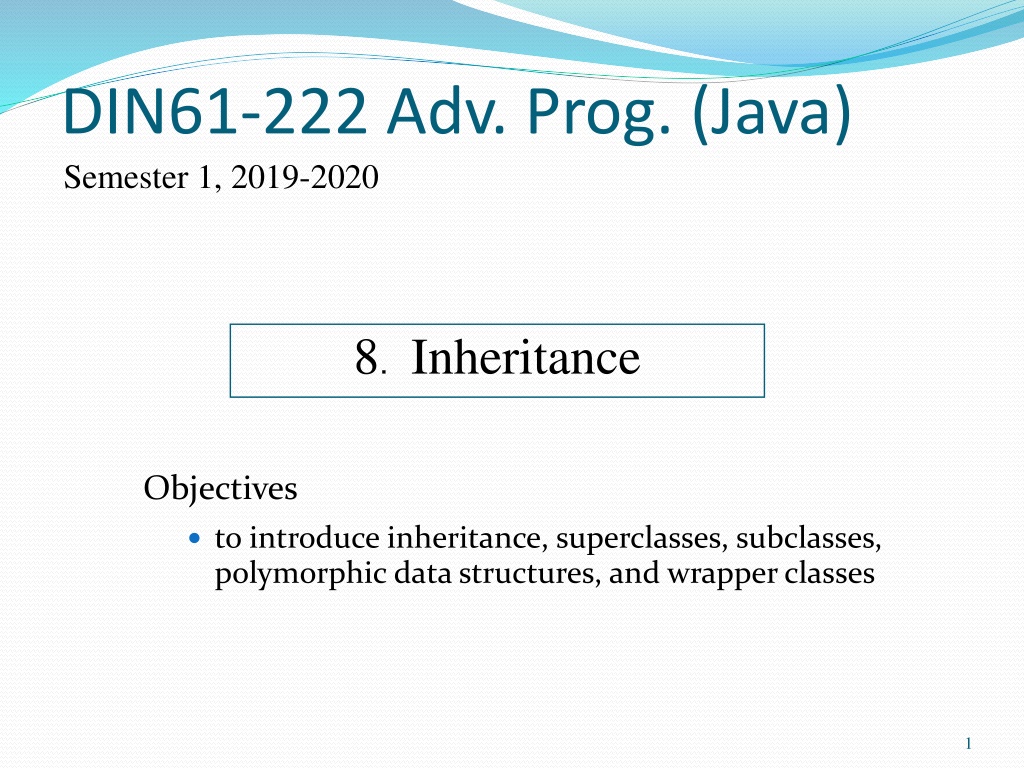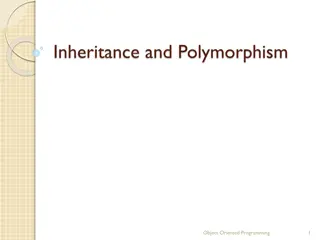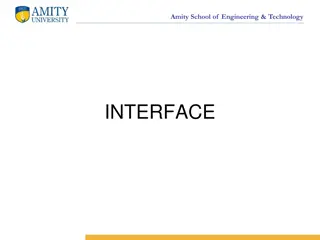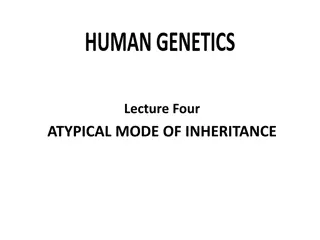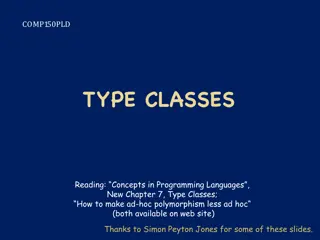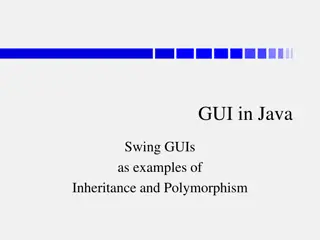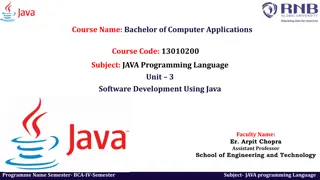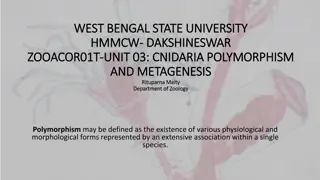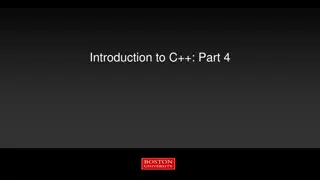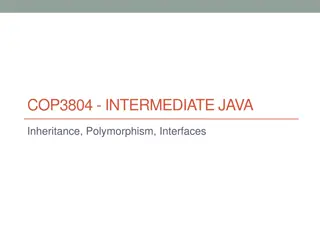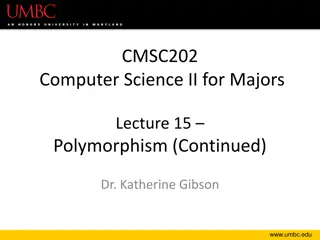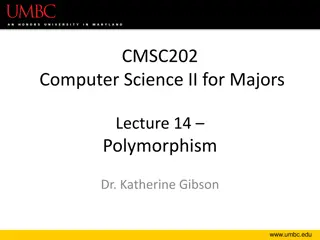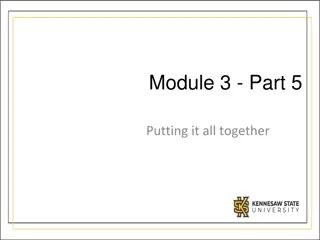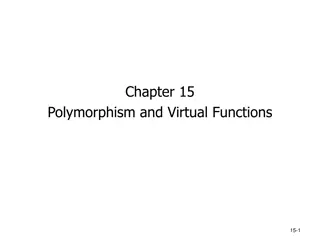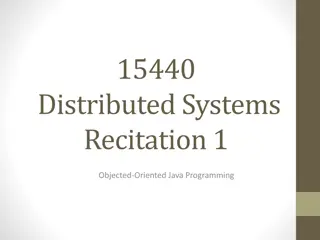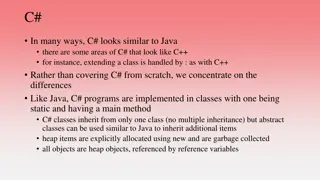Introduction to Inheritance and Polymorphism in Java Programming
This course material covers the concepts of inheritance, superclasses, subclasses, polymorphic data structures, and wrapper classes in Java programming. It introduces the DoME example - a multimedia entertainment database, showcasing the implementation of classes like CD and DVD. The details of CD and DVD classes, their methods, and relationships are discussed, highlighting the use of inheritance for code reusability and polymorphic behavior. Through illustrations and explanations, learners gain a solid understanding of how to implement and utilize inheritance in Java programming.
Download Presentation

Please find below an Image/Link to download the presentation.
The content on the website is provided AS IS for your information and personal use only. It may not be sold, licensed, or shared on other websites without obtaining consent from the author. Download presentation by click this link. If you encounter any issues during the download, it is possible that the publisher has removed the file from their server.
E N D
Presentation Transcript
DIN61-222 Adv. Prog. (Java) Semester 1, 2019-2020 8. Inheritance Objectives to introduce inheritance, superclasses, subclasses, polymorphic data structures, and wrapper classes 1
1. The DoME Example DoME = "Database of Multimedia Entertainment" The database stores details about CDs and DVDs in ArrayLists CD: title, artist, no. of tracks, playing time, a got-it, flag, a comment DVD: title, director, playing time, got-it, comment The details can be printed. 2
DoME Classes "uses" 3
The CD Class public class CD { private String title, artist, comment; private int numberOfTracks, playingTime; private boolean gotIt; public CD(String theTitle, String theArtist, int tracks, int time) { title = theTitle; artist = theArtist; numberOfTracks = tracks; playingTime = time; gotIt = false; comment = null; } // end of CD() continued 5
public void setComment(String com) { comment = com; } public String getComment() { return comment; } public void setOwn(boolean ownIt) // set the flag indicating whether we own this CD. { gotIt = ownIt; } public boolean getOwn() // return true if we own a copy of this CD. { return gotIt; } continued 6
public void print() // print details about this CD { System.out.print("CD: " + title + " (" + playingTime + " mins)"); if (gotIt) System.out.println("*"); else System.out.println(); System.out.println(" " + artist); System.out.println(" tracks: " + numberOfTracks); if (comment != null) System.out.println(" " + comment); } // end of print() } // end of CD class 7
The DVD Class public class DVD { private String title, director, comment; private int playingTime; // playing time of the movie private boolean gotIt; public DVD(String theTitle, String theDirector, int time) { title = theTitle; director = theDirector; playingTime = time; gotIt = false; comment = null; } // end of DVD() Notice the many similarities with the CD class. continued 8
public void setComment(String com) { comment = com; } public String getComment() { return comment; } public void setOwn(boolean ownIt) // set the flag indicating whether we own this DVD. { gotIt = ownIt; } public boolean getOwn() // return true if we own a copy of this DVD. { return gotIt; } continued 9
public void print() // print details about this DVD { System.out.print("DVD: " + title + " (" + playingTime + " mins)"); if (gotIt) System.out.println("*"); else System.out.println(); System.out.println(" " + director); if (comment != null) System.out.println(" " + comment); } // end of print() } // end of DVD class 10
The Database Class public class Database { private ArrayList<CD> cds; private ArrayList<DVD> dvds; Notice the code duplication due to the use of two ArrayLists. public Database() { cds = new ArrayList<CD>(); dvds = new ArrayList<DVD>(); } public void addCD(CD theCD) { cds.add(theCD); } public void addDVD(DVD theDVD) { dvds.add(theDVD); } continued 11
public void list() // print a list of all currently stored CDs and DVDs { for (CD cd : cds) cd.print(); for (DVD dvd : dvds) dvd.print(); } // end of list() } // end of Database class 12
Using the DoME Database public class UseDome1 { public static void main(String[] args) { Database db = new Database(); CD beatles = new CD("the white album", "the beatles",13, 122); db.addCD( beatles); beatles.setComment("the best of the later period"); db.addCD( new CD("morrison hotel", "the doors", 11, 109)); db.addCD( new CD("dark side of the moon","pink floyd",9,100)); : continued 13
db.addDVD( new DVD("citizen kane", "welles", 97)); DVD drs = new DVD("dr. strangelove", "kubrick", 143); drs.setComment("what was written on the bomb?"); db.addDVD(drs); db.addDVD( new DVD("star wars: a new hope", "lucas", 100)); db.list(); } // end of UseDome1() } // end of UseDome1 class 14
Execution 15
Problems with DoME's Design Code duplication: the CD and DVD classes are very similar it makes maintenance harder it introduces the danger of bugs The Database class also suffers from code duplication. 16
2. Inheritance Hierarchies "is a" 17
3. DoME using Inheritance Compare the fields and methods with those for CD and DVD in slide 4. "is a" 18
Inheritance Terminlogy The Item class is a superclass. The new versons of the CD and DVD classes are subclasses the superclass defines fields (attributes) and methods which are inherited by the subclasses the subclasses add extra fields and methods 19
The Item Class public class Item { private String title, comment; private int playingTime; private boolean gotIt; Fields and methods that were common to the old CD and DVD classes are now in the Item superclass. public Item(String theTitle, int time) { title = theTitle; playingTime = time; gotIt = false; comment = null; } continued 20
public void setComment(String com) { comment = com; } public String getComment() { return comment; } public void setOwn(boolean ownIt) // set the flag indicating whether we own this item. { gotIt = ownIt; } public boolean getOwn() // return true if we own a copy of this item. { return gotIt; } continued 21
public void print() // print details about this item { System.out.print("title: " + title + " (" + playingTime + " mins)"); if (gotIt) System.out.println("*"); else System.out.println(); if (comment != null) System.out.println(" " + comment); } // end of print() } // end of Item class 22
The Revised CD Class public class CD extends Item { private String artist; private int numTracks; public CD(String theTitle, String theArtist, int tracks, int time) { super(theTitle, time); artist = theArtist; numTracks = tracks; } Much shorter than the old CD class. public String getArtist() { return artist; } public int getNumberOfTracks() { return numTracks; } } // end of CD class 23
How is this Line Now Executed? CD beatles = new CD("the white album", "the beatles",13, 122); 24
The Revised DVD Class public class DVD extends Item { private String director; public DVD(String theTitle, String theDirector, int time) { super(theTitle, time); director = theDirector; } Much shorter than the old DVD class. public String getDirector() { return director; } } // end of DVD class 25
How is this Line Executed? DVD d1 = new DVD("citizen kane", "welles", 97) 26
Superclass Constructor Call The subclass constructors should always contain a super() call as the first statement. CD has 6 fields (4 inherited) and 9 methods (6 inherited) DVD has 5 fields (4 inherited) and 8 methods (6 inherited) 27
Adding More Item Subclasses "is a" continued 28
"is a" 29
The Benefits of Inheritance A comparison between the old and new versions of CD and DVD show: no code duplication code reuse (of Item) Inheritance simplifies: maintenance, extendibility 30
4. Polymorphism A superclass variable can be assigned any subclass object: Item a1 = new CD(...); Item a2 = new DVD(...); "is a" continued 31
This polymorphic feature becomes very useful when a collection (e.g. ArrayList, array, HashMap) is defined using a superclass the collection can store subclass objects 32
Polymorphic Data Structures Normal data structures (e.g. int a[]) can only hold one type of thing (e.g integers). A polymorphic data structure can hold different types of objects the trick is to define the data structure using a superclass (e.g. Item) it can then hold subclass objects (e.g. CD, DVD) 33
Items ArrayList : ArrayList<Item> items = new ArrayList<Item>; items.add( new CD(...) ); items.add( new DVD(...) ); items.add( new CD(...) ); items.add( new DVD(...) ); : any subclass objects of Item . . . . items 34
5. The Revised Database Class import java.util.ArrayList; Only one ArrayList, and only Item objects are being manipulated. public class Database { private ArrayList<Item> items; public Database() { items = new ArrayList<Item>(); } public void addItem(Item theItem) { items.add(theItem); } continued 35
public void list() // print a list of all currently stored items { for (Item item : items) item.print(); } // end of list() No code duplication unlike in the old version of Database. } // end of Database class 36
Class Diagram "uses" o Why does Database now use Item instead of CD and DVD? "is a" o Because Item is a superclass of CD and DVD, which allows Database to manipulate objects of both subclasses. 37
Changes from the Old Database Now there is only one ArrayList, which stores Item objects called a polymorphic data structure The use of a single ArrayList simplifies the Database methods no more code duplication due to the use of two ArrayLists for CDs and DVDs 38
A Polymorphic Interface The itemspolymorphic data structure in Database is accessed using methods that take a superclass parameter (i.e. Item) This means that the methods can accept arguments which are subclass objects (i.e. CD and DVD objects) 39
Superclass Parameters In the first Database class: public void addCD(CD theCD); public void addVideo(DVD theDVD); Now, Database has: public void addItem(Item theItem) This method is called with: DVD myDVD = new DVD(...); database.addItem(myDVD); CD myCD = new CD(...); database.addItem(myCD); A subclass object can be passed to the Item superclass parameter of addItem(). 40
Using DoME (v.2) public class UseDome2 { public static void main(String[] args) { Database db = new Database(); CD beatles = new CD("the white album", "the beatles",13,122); db.addItem(beatles); beatles.setComment("the best of the later period"); db.addItem(new CD("morrison hotel", "the doors", 11, 109)); db.addItem(new CD("dark side of the moon","pink floyd",9,100)); : continued 41
db.addItem(new DVD("citizen kane", "welles", 97)); DVD drs = new DVD("dr. strangelove", "kubrick", 143); drs.setComment("what was written on the bomb?"); db.addItem(drs); db.addItem(new DVD("star wars: a new hope", "lucas", 100)); db.list(); } // end of UseDome2() } // end of UseDome2 class 42
Compare with the old version of Database shown in slide 4. Object Diagram 43
Execution There's a 'problem' with this output, which I'll discuss (and fix) in Part 9. Compare with slide 15 44
6. A Vehicle Example Vehicle is a superclass, with subclasses for different types of vehicles. wheels, seats "is a" an engine a bell 45
A Vehicle Array This time the polymorphic data structure is an array. : Vehicle vs[] = new Vehicle[100]; vs[0] = new Bicycle(...); vs[1] = new Car(...); vs[2] = new Bicycle(...); vs[3] = new Car(...); : any subclass object of Vehicle . . . . vs 46
One-way Casting We can assign subclass objects to superclass variables: Vehicle v = new Bicycle(...); // ok Ok since a bicycle has all the features of a vehicle, and some extra ones (e.g. a bell) which do not matter. continued 47
In general, we cannot assign superclass objects to subclass variables: Bicycle b = new Vehicle(...); // compile-time error An error since a vehicle does not have all the features of a bicycle (e.g. no bell). 48
7. The Object Class All classes are subclasses of the Object class Object is a sort of "super-grandfather" of every class "is a" All classes inherit from Object. continued 49
This means that a collection (ArrayList, array, etc) of type Object can store any kind of object: ArrayList<Object> list = new ArrayList<Object>(); list.add( "andrew" ); list.add( new CD(...) ); list.add( new Bike(...) ); 50
